TOYOTA PRIUS PRIME 2023 Owner's Guide
Manufacturer: TOYOTA, Model Year: 2023, Model line: PRIUS PRIME, Model: TOYOTA PRIUS PRIME 2023Pages: 680, PDF Size: 14.97 MB
Page 31 of 680
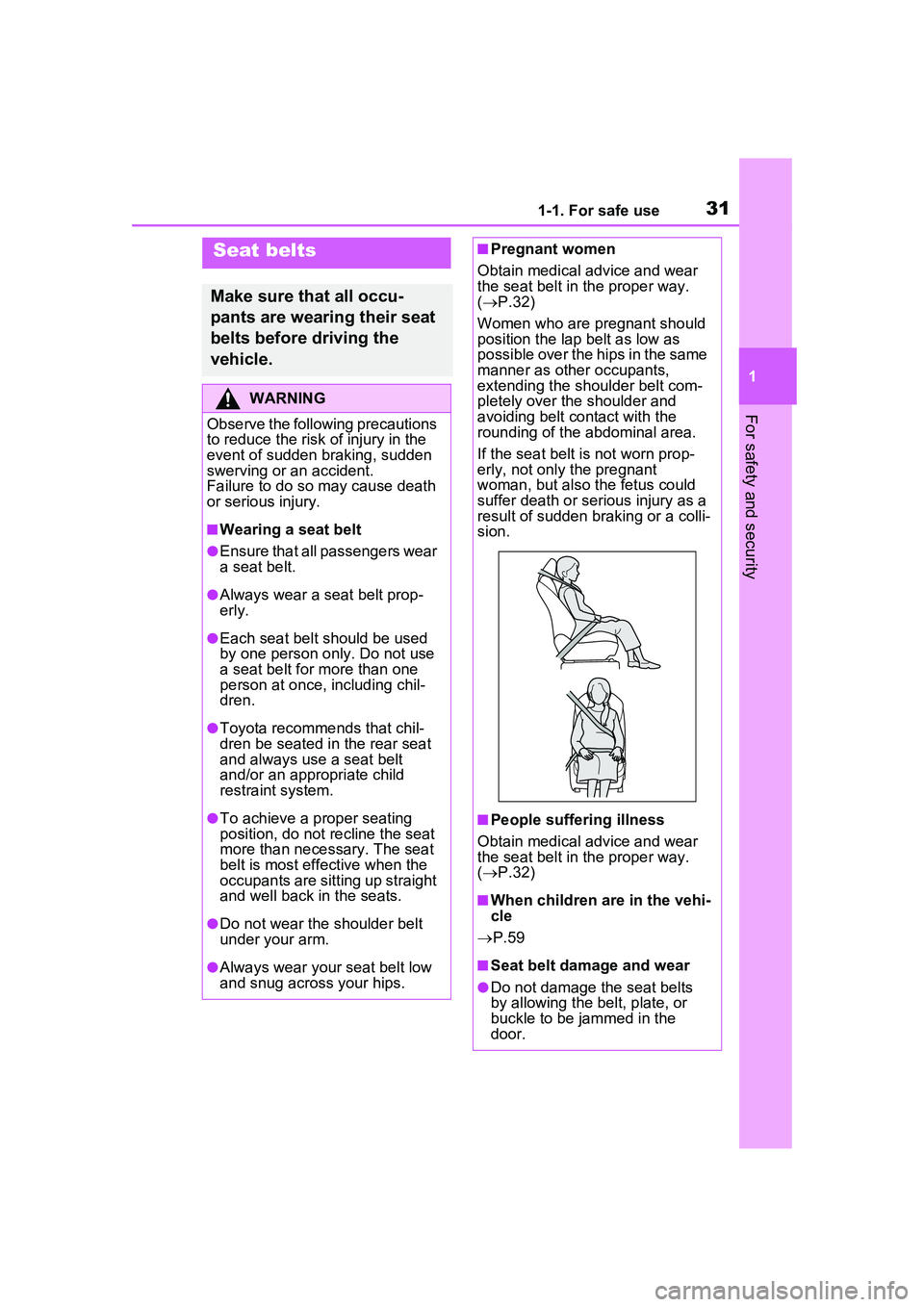
311-1. For safe use
1
For safety and security
Seat belts
Make sure that all occu-
pants are wearing their seat
belts before driving the
vehicle.
WARNING
Observe the following precautions
to reduce the risk of injury in the
event of sudden braking, sudden
swerving or an accident.
Failure to do so may cause death
or serious injury.
■Wearing a seat belt
●Ensure that all passengers wear
a seat belt.
●Always wear a seat belt prop-
erly.
●Each seat belt should be used
by one person only. Do not use
a seat belt for more than one
person at once, including chil-
dren.
●Toyota recommends that chil-
dren be seated in the rear seat
and always use a seat belt
and/or an appropriate child
restraint system.
●To achieve a proper seating
position, do not recline the seat
more than necessary. The seat
belt is most effective when the
occupants are sitting up straight
and well back in the seats.
●Do not wear the shoulder belt
under your arm.
●Always wear your seat belt low
and snug across your hips.
■Pregnant women
Obtain medical advice and wear
the seat belt in the proper way.
( P.32)
Women who are pregnant should
position the lap belt as low as
possible over the hips in the same
manner as other occupants,
extending the shoulder belt com-
pletely over the shoulder and
avoiding belt contact with the
rounding of the abdominal area.
If the seat belt is not worn prop-
erly, not only the pregnant
woman, but also the fetus could
suffer death or serious injury as a
result of sudden braking or a colli-
sion.
■People suffering illness
Obtain medical advice and wear
the seat belt in the proper way.
( P.32)
■When children are in the vehi-
cle
P.59
■Seat belt damage and wear
●Do not damage the seat belts
by allowing the belt, plate, or
buckle to be jammed in the
door.
Page 32 of 680
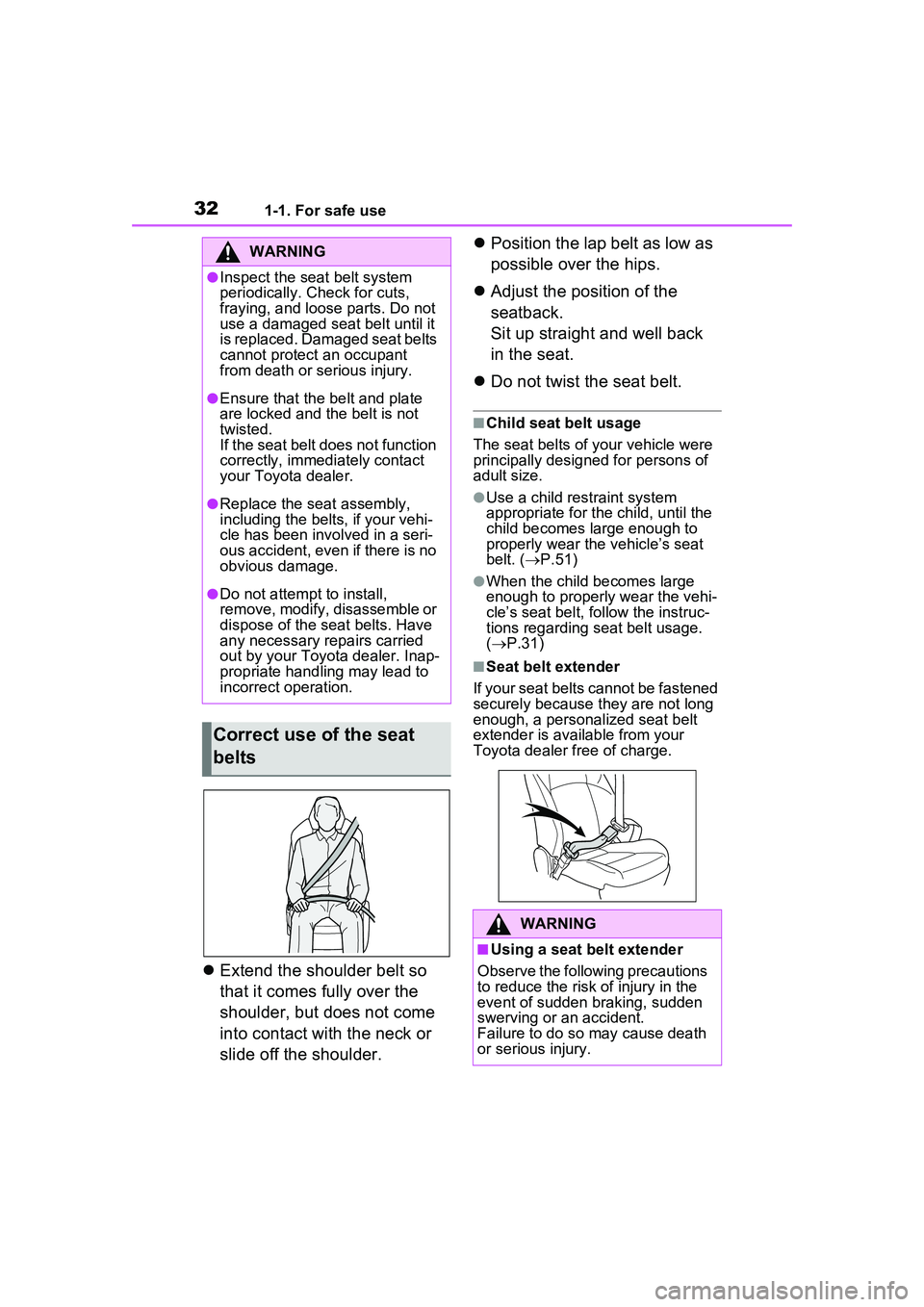
321-1. For safe use
Extend the shoulder belt so
that it comes fully over the
shoulder, but does not come
into contact with the neck or
slide off the shoulder.
Position the lap belt as low as
possible over the hips.
Adjust the position of the
seatback.
Sit up straight and well back
in the seat.
Do not twist the seat belt.
■Child seat belt usage
The seat belts of your vehicle were
principally designed for persons of
adult size.
●Use a child restraint system
appropriate for the child, until the
child becomes large enough to
properly wear the vehicle’s seat
belt. ( P.51)
●When the child becomes large
enough to properly wear the vehi-
cle’s seat belt, follow the instruc-
tions regarding seat belt usage.
( P.31)
■Seat belt extender
If your seat belts cannot be fastened
securely because they are not long
enough, a personalized seat belt
extender is available from your
Toyota dealer free of charge.
WARNING
●Inspect the seat belt system
periodically. Check for cuts,
fraying, and loose parts. Do not
use a damaged seat belt until it
is replaced. Damaged seat belts
cannot protect an occupant
from death or serious injury.
●Ensure that the belt and plate
are locked and the belt is not
twisted.
If the seat belt does not function
correctly, immediately contact
your Toyota dealer.
●Replace the seat assembly,
including the belts, if your vehi-
cle has been involved in a seri-
ous accident, even if there is no
obvious damage.
●Do not attempt to install,
remove, modify, disassemble or
dispose of the seat belts. Have
any necessary repairs carried
out by your Toyota dealer. Inap-
propriate handling may lead to
incorrect operation.
Correct use of the seat
belts
WARNING
■Using a seat belt extender
Observe the following precautions
to reduce the risk of injury in the
event of sudden braking, sudden
swerving or an accident.
Failure to do so may cause death
or serious injury.
Page 33 of 680
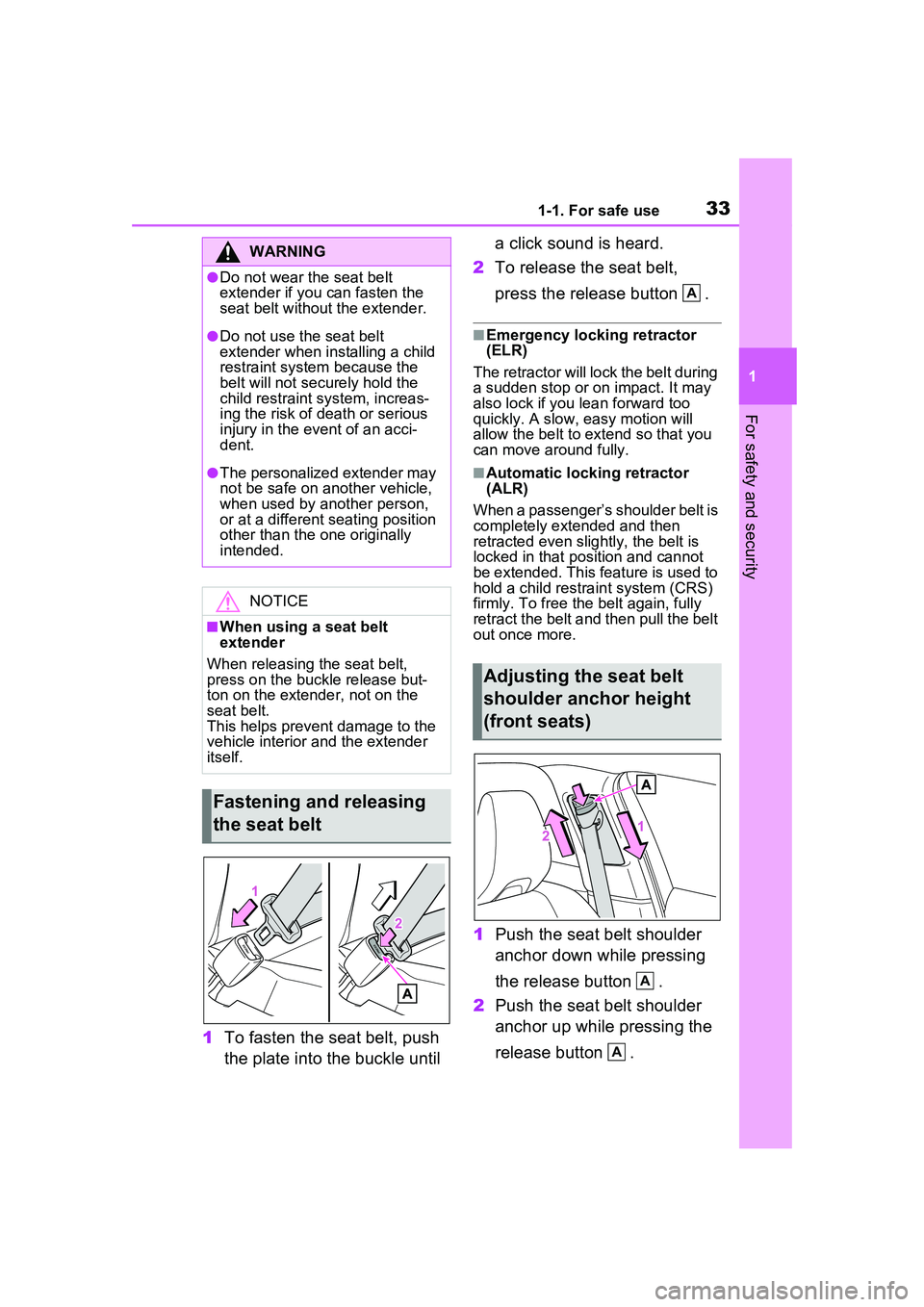
331-1. For safe use
1
For safety and security
1To fasten the seat belt, push
the plate into the buckle until a click sound is heard.
2 To release the seat belt,
press the release button .
■Emergency locking retractor
(ELR)
The retractor will lock the belt during
a sudden stop or on impact. It may
also lock if you lean forward too
quickly. A slow, easy motion will
allow the belt to extend so that you
can move around fully.
■Automatic locking retractor
(ALR)
When a passenger’s shoulder belt is
completely extended and then
retracted even slightly, the belt is
locked in that position and cannot
be extended. This feature is used to
hold a child restra int system (CRS)
firmly. To free the belt again, fully
retract the belt and then pull the belt
out once more.
1 Push the seat belt shoulder
anchor down while pressing
the release button .
2 Push the seat belt shoulder
anchor up while pressing the
release button .
WARNING
●Do not wear the seat belt
extender if you can fasten the
seat belt without the extender.
●Do not use the seat belt
extender when installing a child
restraint system because the
belt will not securely hold the
child restraint system, increas-
ing the risk of death or serious
injury in the event of an acci-
dent.
●The personalized extender may
not be safe on another vehicle,
when used by another person,
or at a different seating position
other than the one originally
intended.
NOTICE
■When using a seat belt
extender
When releasing the seat belt,
press on the buckle release but-
ton on the extender, not on the
seat belt.
This helps prevent damage to the
vehicle interior and the extender
itself.
Fastening and releasing
the seat belt
Adjusting the seat belt
shoulder anchor height
(front seats)
A
A
A
Page 34 of 680

341-1. For safe use
Move the height adjuster up and
down as needed until you hear a
click.
When the vehicle is subjected to
a severe frontal or side impact
or rollover, the pretensioners
retract the seat belts of the front
seats and rear outer seats to
securely restrain the occupants.
The pretensioners will not operate
in minor frontal or side impacts, or
rear impacts.
■Replacing the belt after the pre-
tensioner has been activated
If the vehicle is in volved in multiple collisions, the pretensioner will acti-
vate for the first collision, but will not
activate for the second or subse-
quent collisions.
■PCS-linked control
If the PCS (Pre-Collision System)
determines that th e possibility of a
collision with a vehicle is high, the
seat belt pretensioners will be pre-
pared to operate.WARNING
■Adjustable shoulder anchor
Always make sure the shoulder
belt is positioned across the cen-
ter of your shoulder. The belt
should be kept away from your
neck, but not falling off your
shoulder. Failure to do so could
reduce the amount of protection in
an accident and cause death or
serious injuries in the event of a
sudden stop, sudden swerve or
accident.
Seat belt pretensioners
(front seats and outboard
rear seats)
WARNING
■Seat belt pretensioners
Observe the following precautions
to reduce the risk of injury in the
event of sudden braking or an
accident.
Failure to do so may result in
death or serious injury.
●Do not place anything, such as
a cushion, on the front passen-
ger’s seat. Doing so will
disperse the passenger’s
weight, which prevents the sen-
sor from detecting the passen-
ger’s weight properly. As a
result, the seat belt pretensioner
for the front passenger’s seat
may not operate in the event of
a collision.
●If a pretensioner has operated,
the SRS warning light will illumi-
nate. In this situation, the seat
belt cannot be used and must
be replaced by your Toyota
dealer.
Page 35 of 680
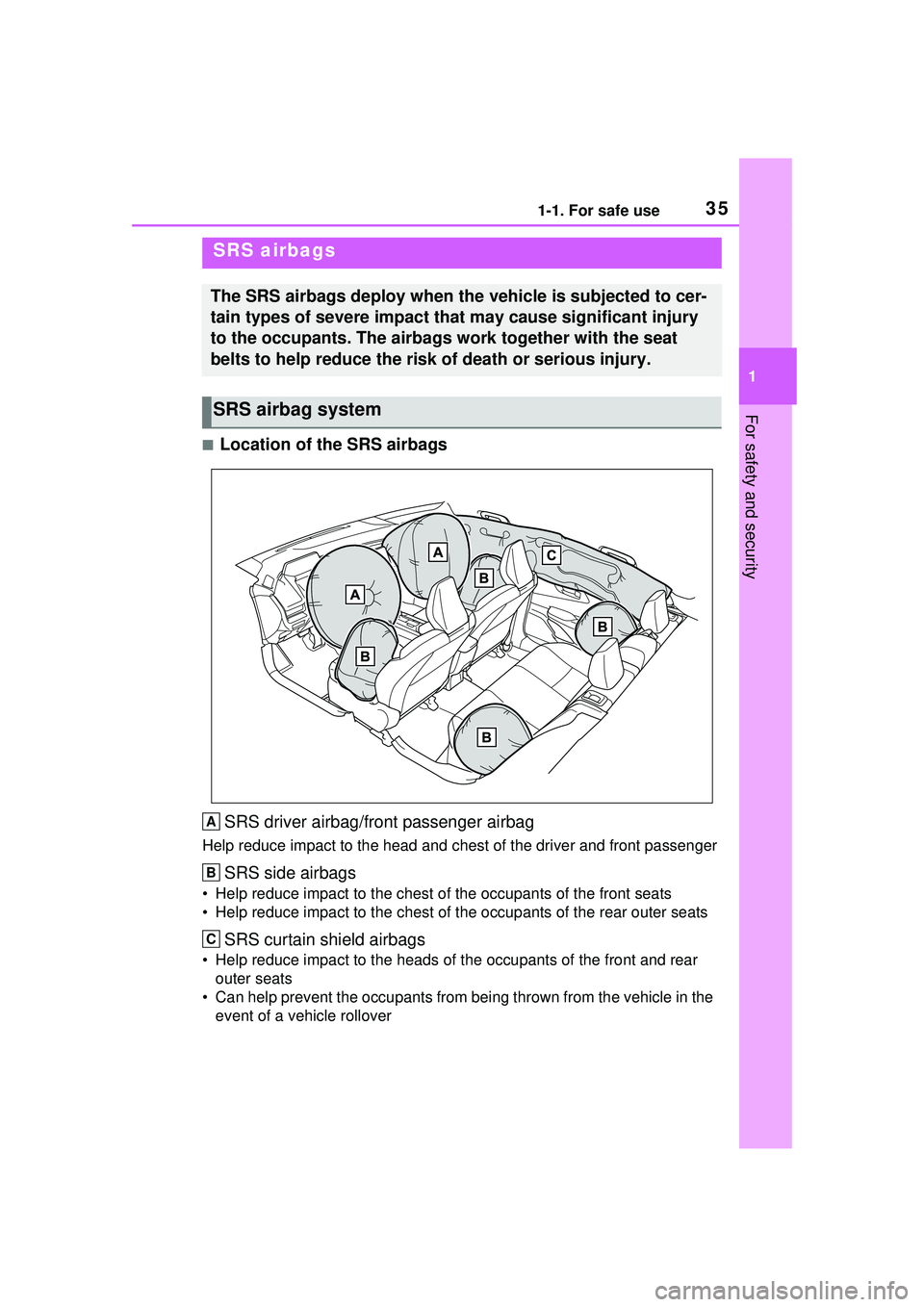
351-1. For safe use
1
For safety and security
■Location of the SRS airbagsSRS driver airbag/front passenger airbag
Help reduce impact to the head and chest of the driver and front passenger
SRS side airbags
• Help reduce impact to the chest of the occupants of the front seats
• Help reduce impact to the chest of th e occupants of the rear outer seats
SRS curtain shield airbags
• Help reduce impact to the heads of the occupants of the front and rear
outer seats
• Can help prevent the occupants from being thrown from the vehicle in the event of a vehicle rollover
SRS airbags
The SRS airbags deploy when the vehicle is subjected to cer-
tain types of severe impact that may cause significant injury
to the occupants. The airbags work together with the seat
belts to help reduce the risk of death or serious injury.
SRS airbag system
A
B
C
Page 36 of 680

361-1. For safe use
■SRS airbag system componentsFront impact sensors
Front passenger airbag
Side impact sensors (front door)
Curtain shield airbags
Side impact sensors (front)
Seat belt pretensioners and force limiters
Front side airbags
“PASSENGER AIR BAG ON” and “PASSENGER AIR BAG OFF”
indicator lights
Rear side airbags
Front passenger’s seat belt buckle switch
Driver airbag
Front passenger occupant classification sensors
SRS warning light
Airbag sensor assembly
Your vehicle is equipped with ADVANCED AIRBAGS designed
based on US motor vehicle safety standards (FMVSS208). The air-
A
B
C
D
E
F
G
H
I
J
K
L
M
N
Page 37 of 680
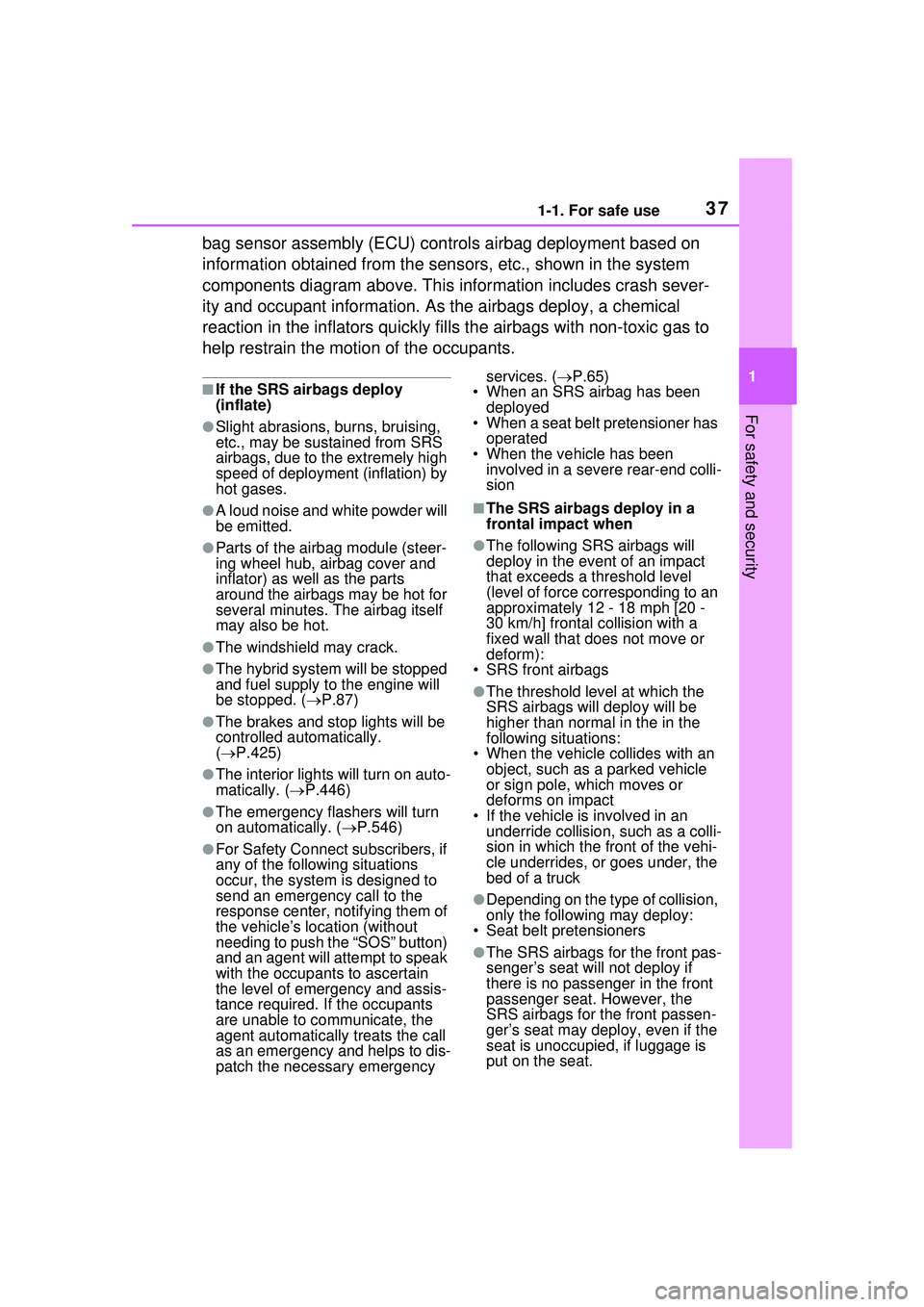
371-1. For safe use
1
For safety and security
bag sensor assembly (ECU) controls airbag deployment based on
information obtained from the sensors, etc., shown in the system
components diagram above. This information includes crash sever-
ity and occupant information. As the airbags deploy, a chemical
reaction in the inflators quickly fills the airbags with non-toxic gas to
help restrain the motion of the occupants.
■If the SRS airbags deploy
(inflate)
●Slight abrasions, burns, bruising,
etc., may be sustained from SRS
airbags, due to the extremely high
speed of deployment (inflation) by
hot gases.
●A loud noise and white powder will
be emitted.
●Parts of the airbag module (steer-
ing wheel hub, airbag cover and
inflator) as well as the parts
around the airbags may be hot for
several minutes. The airbag itself
may also be hot.
●The windshield may crack.
●The hybrid system will be stopped
and fuel supply to the engine will
be stopped. (P.87)
●The brakes and st op lights will be
controlled automatically.
( P.425)
●The interior lights will turn on auto-
matically. ( P.446)
●The emergency flashers will turn
on automatically. ( P.546)
●For Safety Connect subscribers, if
any of the following situations
occur, the system is designed to
send an emergency call to the
response center, notifying them of
the vehicle’s location (without
needing to push the “SOS” button)
and an agent will a ttempt to speak
with the occupants to ascertain
the level of emergency and assis-
tance required. If the occupants
are unable to communicate, the
agent automatically treats the call
as an emergency and helps to dis-
patch the necessary emergency services. (
P.65)
• When an SRS airbag has been deployed
• When a seat belt pretensioner has
operated
• When the vehicle has been involved in a severe rear-end colli-
sion
■The SRS airbags deploy in a
frontal impact when
●The following SRS airbags will
deploy in the event of an impact
that exceeds a threshold level
(level of force corresponding to an
approximately 12 - 18 mph [20 -
30 km/h] frontal collision with a
fixed wall that does not move or
deform):
• SRS front airbags
●The threshold level at which the
SRS airbags will deploy will be
higher than normal in the in the
following situations:
• When the vehicle collides with an
object, such as a parked vehicle
or sign pole, which moves or
deforms on impact
• If the vehicle is involved in an underride collision, such as a colli-
sion in which the front of the vehi-
cle underrides, or goes under, the
bed of a truck
●Depending on the type of collision,
only the following may deploy:
• Seat belt pretensioners
●The SRS airbags for the front pas-
senger’s seat will not deploy if
there is no passenger in the front
passenger seat. However, the
SRS airbags for the front passen-
ger’s seat may deploy, even if the
seat is unoccupied, if luggage is
put on the seat.
Page 38 of 680

381-1. For safe use
●In the event of an especially
severe frontal collision, the left
and right SRS curtain shield air-
bags may also deploy.
■The SRS airbags deploy in a
side impact when
●The following SRS airbags will
deploy in the event of an impact
that exceeds the set threshold
level (level of force corresponding
to the impact force produced by
an approximately 3300 lb. [1500
kg] vehicle collidin g with the pas-
senger compartment at a perpen-
dicular angle at an approximate
speed of 12 - 18 mph [20 - 30
km/h]):
• SRS side airbags
• SRS curtain shield airbags
●In the event of a side collision,
regardless of the impacted side,
both the left and right SRS curtain
shield airbags will deploy.
●If the vehicle is involved in a roll-
over, the following SRS airbags
will deploy:
• Both left and right SRS curtain shield airbags
■The SRS airbags deploy in an
underside impact when
●The following airbags may deploy
if the underside of the vehicle col-
lides with a hard object:
• SRS front airbags
• SRS side airbags
• SRS curtain shield airbags
●The following airbags may deploy
if the vehicle becomes signifi-
cantly tilted or is strongly impacted
by skidding into a curb, etc.:
• SRS curtain shield airbags
■The SRS side airbags will not
deploy when
●The following SRS airbags will not
normally deploy in side or rear col-
lisions, vehicle rollovers, or low
speed frontal collisions. However,
if such a collision causes sufficient
sudden deceleration, the SRS air-
bags may deploy.
• SRS front airbags
●The following SRS airbags may
not deploy if the vehicle is collided
with at a certain angle or in a side
collision where an area of the
vehicle other than the passenger
compartment is collided with:
• SRS side airbags
• SRS curtain shield airbags
●The following SRS airbags will not
normally deploy in front or rear
collisions, vehicle rollovers, or low
speed side collisions:
• SRS side airbags
Page 39 of 680
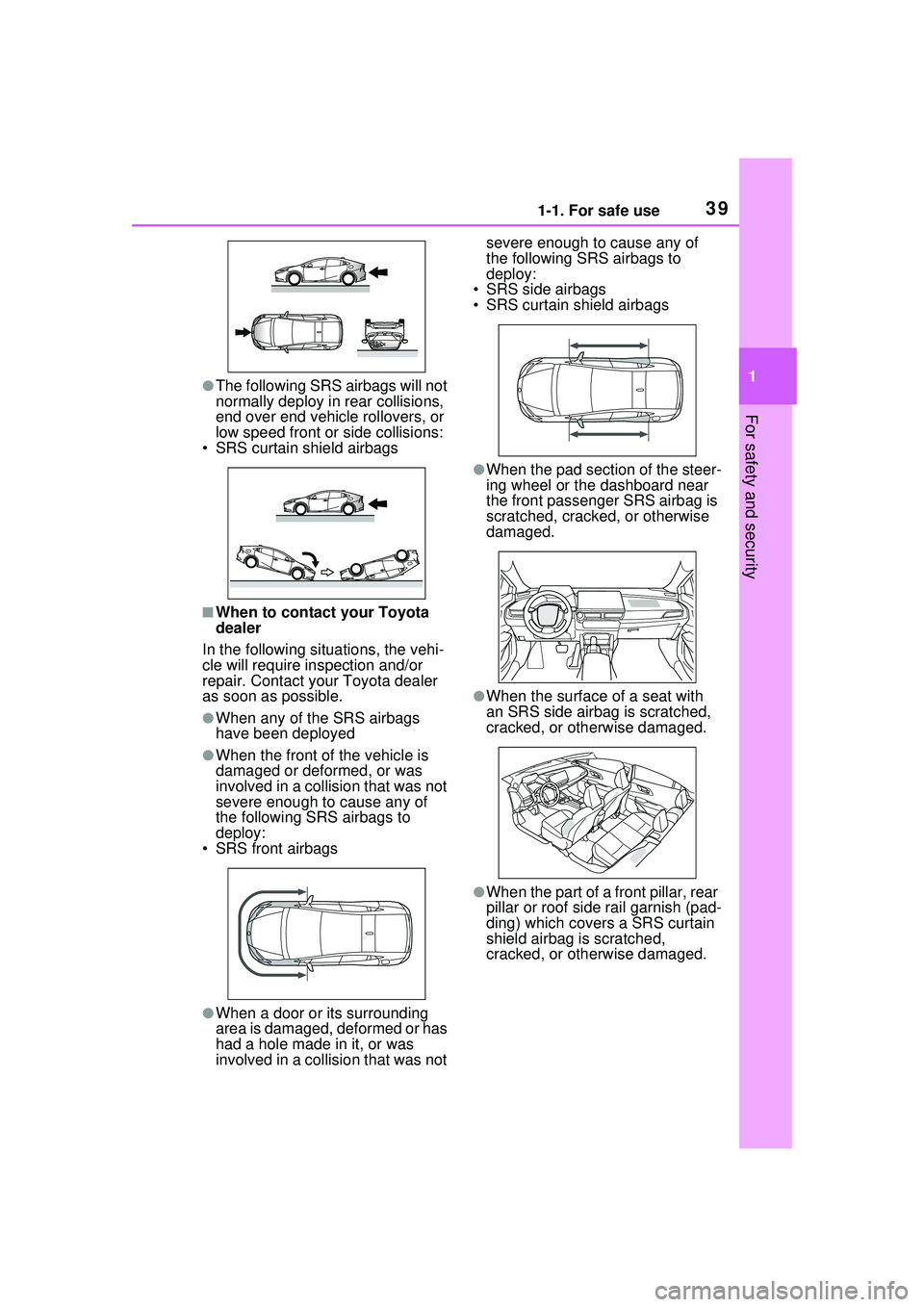
391-1. For safe use
1
For safety and security
●The following SRS airbags will not
normally deploy in rear collisions,
end over end vehicle rollovers, or
low speed front or side collisions:
• SRS curtain shield airbags
■When to contact your Toyota
dealer
In the following situations, the vehi-
cle will require inspection and/or
repair. Contact your Toyota dealer
as soon as possible.
●When any of the SRS airbags
have been deployed
●When the front of the vehicle is
damaged or deformed, or was
involved in a collision that was not
severe enough to cause any of
the following SRS airbags to
deploy:
• SRS front airbags
●When a door or its surrounding
area is damaged, deformed or has
had a hole made in it, or was
involved in a collision that was not severe enough to cause any of
the following SRS airbags to
deploy:
• SRS side airbags
• SRS curtain shield airbags
●When the pad section of the steer-
ing wheel or the dashboard near
the front passenger SRS airbag is
scratched, cracked, or otherwise
damaged.
●When the surface of a seat with
an SRS side airbag is scratched,
cracked, or otherwise damaged.
●When the part of a front pillar, rear
pillar or roof side rail garnish (pad-
ding) which covers a SRS curtain
shield airbag is scratched,
cracked, or otherwise damaged.
Page 40 of 680
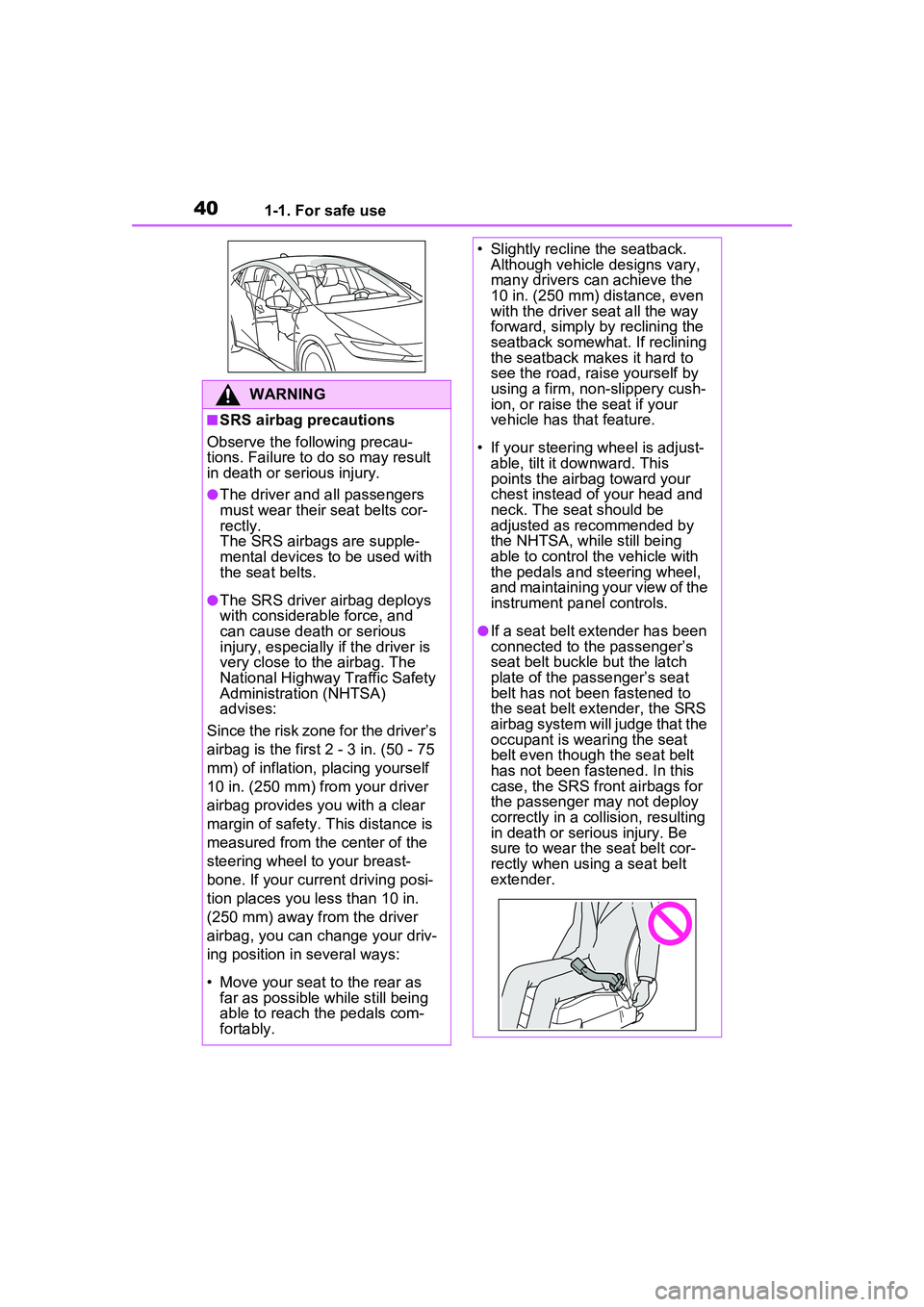
401-1. For safe use
WARNING
■SRS airbag precautions
Observe the following precau-
tions. Failure to do so may result
in death or serious injury.
●The driver and all passengers
must wear their seat belts cor-
rectly.
The SRS airbags are supple-
mental devices to be used with
the seat belts.
●The SRS driver airbag deploys
with considerable force, and
can cause death or serious
injury, especially if the driver is
very close to the airbag. The
National Highway Traffic Safety
Administration (NHTSA)
advises:
Since the risk zone for the driver’s
airbag is the first 2 - 3 in. (50 - 75
mm) of inflation, placing yourself
10 in. (250 mm) from your driver
airbag provides you with a clear
margin of safety. This distance is
measured from the center of the
steering wheel to your breast-
bone. If your current driving posi-
tion places you less than 10 in.
(250 mm) away from the driver
airbag, you can change your driv-
ing position in several ways:
• Move your seat to the rear as far as possible while still being
able to reach the pedals com-
fortably.
• Slightly recline the seatback. Although vehicle designs vary,
many drivers can achieve the
10 in. (250 mm) distance, even
with the driver seat all the way
forward, simply by reclining the
seatback somewhat. If reclining
the seatback makes it hard to
see the road, raise yourself by
using a firm, non-slippery cush-
ion, or raise the seat if your
vehicle has that feature.
• If your steering wheel is adjust- able, tilt it downward. This
points the airbag toward your
chest instead of your head and
neck. The seat should be
adjusted as recommended by
the NHTSA, while still being
able to control the vehicle with
the pedals and steering wheel,
and maintaining your view of the
instrument panel controls.
●If a seat belt extender has been
connected to the passenger’s
seat belt buckle but the latch
plate of the passenger’s seat
belt has not been fastened to
the seat belt extender, the SRS
airbag system will judge that the
occupant is wearing the seat
belt even though the seat belt
has not been fastened. In this
case, the SRS front airbags for
the passenger may not deploy
correctly in a collision, resulting
in death or serious injury. Be
sure to wear the seat belt cor-
rectly when using a seat belt
extender.